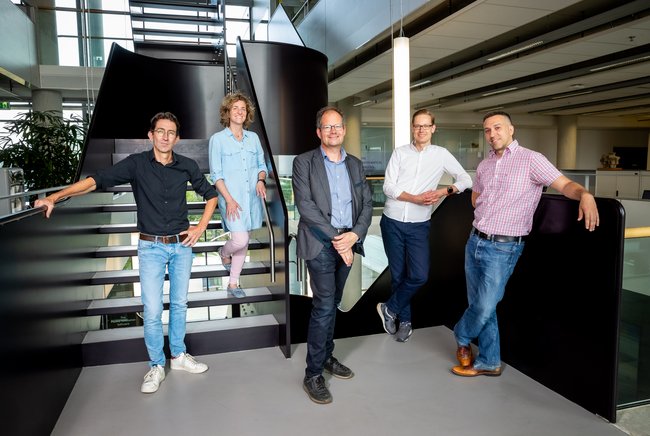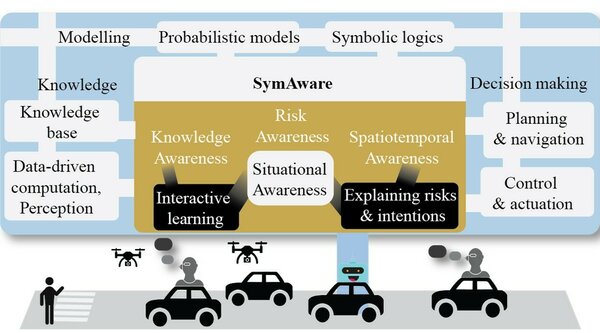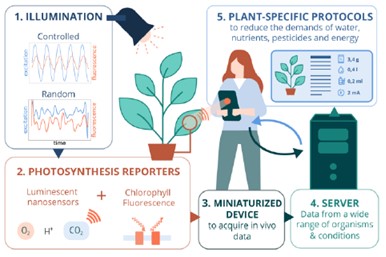Electrical Engineering department receives a further boost through Cyber-Physical System Center Eindhoven (CPSe) efforts
The Cyber-Physical System Center Eindhoven participated in the acquisition of 9 new granted projects related to calls launched in 2021. Those projects bring around 8.2M€ of direct funds to the Electrical Engineering department which will be used, a.o. to hire a total of 22 new temporal employees.

In its self-learning trajectory, CPSe is implementing its new 'research proposition lifecycle' with the emphasis on research leadership in which novel ideas are matured in curiosity, research and mission driven cycle to bring it to a product in the end. Early results have shown that 1 out of 3 projects granted this year are linked to low TRL levels (in 2020 it was 1 out of 10). In addition, 1 out of 3 of the funded projects are led by EE researchers.
CPSe has also increased the number of scientists involved, currently being 22. Most of the scientific staff involved in the center are assistant professors, for whom the center plays a key role in the process of on-boarding, increasing their contact network and supporting the development of research propositions.
Also, this year the center was successful in its supporting activity. 9 out of 19 project proposals in which the center played an active role have been granted. Besides the success with NXTGEN HIGTECH with 7 PhD positions the following 8 European and national projects stand out:

CONVOLVE – Horizon Europe 2021 – Coordination role – 4 temporal positions
Title: Seamless design of Smart Edge Processors
Aim: The CONVOLVE project aims to create a secure by design, ultra-low power processing hardware that supports high throughput, reliable, and secure AI processing on edge devices while reducing the time to market.
TU/e role: TU/e main role is as coordinator of the project. Technically, TU/e will do research on (1) Ultra-low power CGRA for Dynamic ANNs and SNNs, (2) Design-flow for SNNs and ANNs implemented in compiler, (3) Compositional performance analysis and architecture Design Space Exploration (DSE) and (4) Composable and Secure SoC accelerator platform.
Staff involved: Sander Stuijk, Marc Geilen, Manil Dev Gomony, Henk Corporaal and Víctor Sánchez
Sander: "Convolve will enable the next-generation of energy efficient edge compute nodes enabling further advances in our way of living while making major steps towards a sustainable future."
PARASOL – Doctoral Networks (DN) Horizon- MSCA-DN-2021 - Coordination role – 2 temporal positions
Title: European Doctoral Network for Safe and Sustainable by Design Electromagnetic Shielding Solutions for Mobility
Aim: PARASOL has 4 key objectives: scientific, training, Industry-academia network and social impact. The 12 Doctoral Researchers (DRs) will be trained to work in multi-disciplinary and multi-cultural teams, with a new mindset tuned towards the inclusion of the Safe-and-Sustainable-by-Design (SSbD) approach into innovative design methods. For this inclusion to occur, each DR will develop through their research the missing dedicated tools and techniques and apply them to the complete lifecycle of electromagnetic shielding solutions for vehicles (car, plane, train and ship).
TU/e role: TU/e main role is as coordinator. Technically, TU/e will develop neat methods for material characterization, covering a large frequency band (100MHz-10GHz), to measure the complete constituent without modifying the material under test. This novel (in-situ) material characterization method applied to a set carbon-fibre-filled plastic produced with specialists from DEM. To overcome the intrinsic connection limitations in such fibre composites, synergistic filler combinations will be exploited. TU/e will also demonstrate a new approach aiming at maximizing performance of shielding for on-board harnesses.
Staff involved: Anne Roc’h , Guus Pemen, Lisa Seravalle
Anne: “PARASOL has exceptional scientific targets with a strong industrial network representing the compete value chain of EM shielding solution with mobility. It is a first in the field. We all have the common goal of improving safety and sustainability. We are building a new ecosystem and a new design philosophy together with industry. Our future PhD researchers will start with an impactful career.”

E2GO – Doctoral Networks (DN) Horizon- MSCA-DN-2021 -Coordination role – 4 temporal positions
Title: Cost reduction of EV fast-charging station to enable large-scale electrification of mobility
Aim: Within E2GO cross-disciplinary, intersectoral and international collaborations between academic groups and industry partners are formed with a clear main objective: cost-reduction of EV fast-charging infrastructure to enable massive deployment for large-scale electrification of mobility.
TU/e role: TU/e main role is as coordinator. Technically, TU/e will develop the innovations on system architectures with low cost and high efficiency, power density, and reliability through the research on three interfaces: interface with local battery storage, interface with medium voltage grid, and interface with multiple EVs.
Staff involved: Dongsheng Yang, Bas Vermulst, Levy Costa, Guus Pemen, Lisa Seravalle
Dongsheng: “Electric Vehicle running on renewable power is the future, and we would strive to bring that future into reality.”

SymAware – HORIZON-EIC-2021-PATHFINDER CHALLENGES-01 – 2 temporal positions
Title: Symbolic logic framework for situational awareness in mixed autonomy
Aim: SymAware addresses the fundamental need for a new conceptual framework for awareness in multi-agent systems (MASs) that is compatible with the internal models and specifications of robotic agents and that enables safe simultaneous operation of collaborating autonomous agents and humans. The goal of SymAware is to provide a comprehensive framework for situational awareness to support sustainable autonomy via agents that actively perceive risks and collaborate with other robots and humans to improve their awareness and understanding, while fulfilling complex and dynamically changing tasks.
TU/e role: TUE Control Systems Group will bring in expertise on risk quantification and abstractions for stochastic models with an emphasis on the verification of temporal logic specifications over continuous stochastic processes with partial information about the state and the environment.
Staff involved: Sofie Haesaert, Zhiyong Sun
Sofie: “SymAware will allow us to explore how situational awareness can drive acceptance and safety in Multi-Agent Systems.”

DREAM – HORIZON-EIC-2021-PATHFINDEROPEN-01 - 1 temporal position
Title: Dynamic Regulation of photosynthEsis in light-Acclimated organisMs
Aim: Cultivation of plants consumes huge resources of water for irrigation and energy for lighting. Introducing disruptive technologies is key to improve plants and enable their parsimonious cultivation.
DREAM aims to measure and exploit the dynamics of photosynthesis regulation under natural-like light conditions for selective sensing – monitoring the plant state – and enhancing lighting efficiency in controlled environments.
TU/e role: The research in the DREAM project at Control Systems Group will focus on the frequency domain data driven linear/nonlinear modelling of dynamic behaviour of conditioned algae/ plants subjected to fluctuating illumination (lighting).
Staff involved: Leyla Ozkan
Leyla: “This project is literally a dream project for any researcher who like to be challenged to work at the interface of several disciplines. I am particularly excited to bring our modeling expertise to photosynthetic organisms in order to optimize their health and growth while achieving resource efficiency.”
Flex H2 – Vooraanmelding MOOI-SIGOHE (2021)-2 temporal positions
Title: Flexible Offshore Wind Hydrogen Power Plant Module
Aim: The project will develop and demonstrate technology that will accelerate the scale-up of offshore wind, green hydrogen production and its integration in the energy system.
TU/e role: TU/e will contribute to the innovations on the grid-forming offshore wind farm and multi-terminal hybrid HVDC transmission system together with industrial partners. Moreover, a down-scaled demonstrator will be built at the medium voltage lab of TU/e, which is essential to mature the technology innovations and integrations for commercial applications by 2030.
Staff involved: Dongsheng Yang, Guus Pemen
Dr. Yin Sun, the project coordinator from Shell: “The development of this innovative concept is a fantastic example of the collective efforts between industry, academia and governments that will be needed to reach society’s net-zero emissions goals. Shell is committed to supporting the delivery of a sustainable energy system and I am proud that FlexH2 will enable the acceleration of offshore wind development, as well as Power-to-H2 projects”.

Printyourfood – NWO Open Technology Program – 1 temporal position
Title: Control of viscoelastic material deposition for printing of personalized nutrition
Aim: 3D food printing is an emerging technology with the potential to manufacture personalized foods with varying macronutrients and textures. Personalized foods fit in a healthy diet and can thus contribute to lower chronic disease risks. The PRINTYOURFOOD project focuses on understanding the relationships between composition & rheology of food inks, printing/postprocessing conditions and the texture of the end product. The project takes a multidisciplinary approach and will follow three research directions (1) Viscoelastic material deposition behavior: (2) Composition-Texture Decoupling (3) Digital Twinning for Personalized Food Printing.
TU/e role: TU/e will develop a virtual counterpart of the 3D food printing process by combining multiphysics models, printer operations, design requirements, and measured data.
Staff involved: Leyla Özkan
THIO – MOOI-call 2020 – 1 temporal position
Title: The Heat is On
Aim: In the agrofood, paper and specialty chemicals industries 40 to 80 % of CO2 emissions is related to heat driven processes. The Heat is On project aims to reduce fossil fuel consumption and increase energy efficiency by innovative process design in the areas of dewatering, drying and heat integration but also application of digital technologies for smart process operations and control.
TU/e role: TU/e will collaborate with partners in developing digital twining of several energy intensive processes. The main focus will be combination of physics based model with the available measurement data and is directed towards Heat Exchanger Networks
Staff involved: Leyla Özkan
Leyla: “There are still some sectors of process industry that can benefit from advanced digital technologies in reducing their CO2 emissions. The THIO project, therefore, is an excellent example of industry-academia collaboration on a topic of important societal impact."